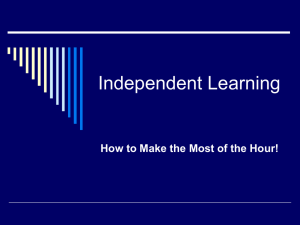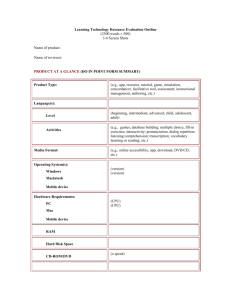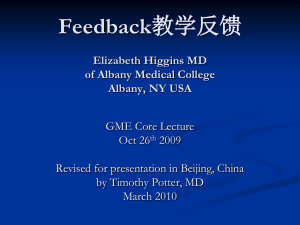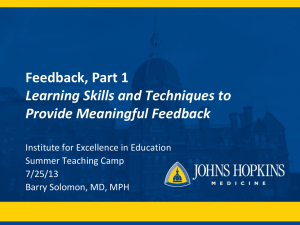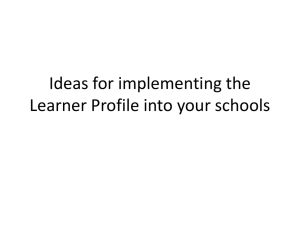Methods
advertisement
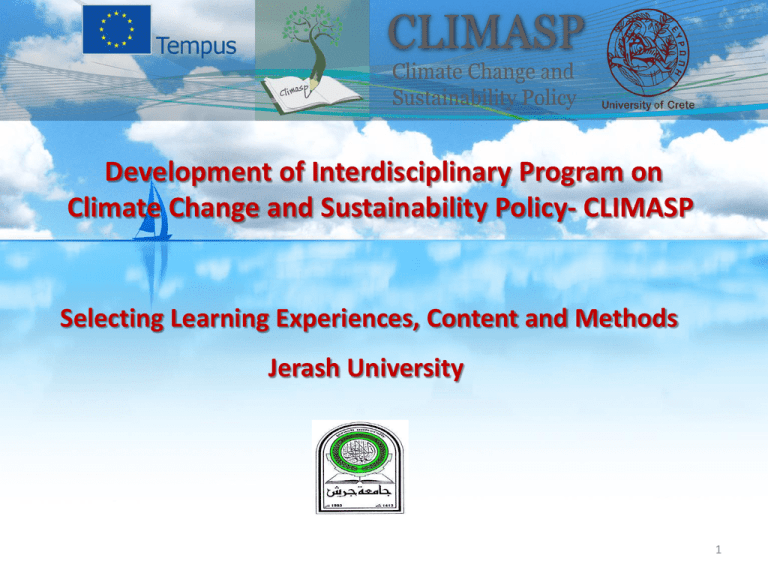
Development of Interdisciplinary Program on Climate Change and Sustainability Policy- CLIMASP Selecting Learning Experiences, Content and Methods Jerash University 1 Learning experiences; A learning experience is the interaction between the learner and the external conditions in the environment to which he can react. Principles to be considered when selecting Learning experiences; 1. Learning is an active process in which the learner must be involved. 2. Learning is affected considerably by individual goals, values and motives. 3. Frequent repetition of response to a class of situations is important in learning skills. 4. The wider the range of experiences presented to the learner, the more likely are the generalizations and discrimination to occur. 2 Criteria for selecting learning experiences; The criteria for selecting learning experiences are derived from the principles of learning; 1. Validity; experiences must be closely connected with the educational goals and result in changed behavior with respect to the stipulated objective. 2. Comprehensiveness; comprehensiveness demands that all the objectives which are stated should have corresponding experiences. 3. Variety; variable learning experiences should be presented. 3 4. Suitability; learning experiences must be closely related to the learner's needs, capacities, interests end ail other factors which condition learning. 5. Balance and continuity; balancing experiences from outside with others from the learning process itself. 6. Relevance; learning experiences should have maximal relation to life. 4 Learning activities; - Learning activities are those which allow students to engage actively with the content. When choosing types of activities, consider: 1. What knowledge/skills do you want the students to have at the end of the course? 2. Do you want to integrate additional collaborative activities, case studies, problem-solving, etc.? 3. Do you want to simply keep the students busy, or do you want the activities to promote deeper learning? 5 Number of activities; To determine how many activities a course should have, the followings should be considered; 1. What is the minimum that students must do in the course to achieve course goals? 2. What can students reasonably do when they are taking other courses, working, and have a family? 3. Do you have time to give feedback for activities and assignments as students progress through projects that take several weeks? 6 Sequence of activities; Before Class Activities Help students prepare for class by giving them assignments such as readings, article reviews, problems, etc. In-Class Activities Give students opportunities to practice the skills and knowledge learned within class discussion and give prompt feedback. Out-ofAllow students to reflect on what they class Activities have learned by activities. 7 Content; Content can be divided into the three domains of knowledge: Skills, Attitudes, and Values. Appropriateness of content is situation driven: what is appropriate for one course may not be appropriate for another. Given this, appropriateness should be defined within the scope of what is; 1. Technically feasible. 2. Socially acceptable. 3. Environmentally safe and sustainable. 8 Technical Feasibility; Technical feasibility should be examined from two perspectives; 1. Ability of the content to meet the course objectives. 2. What the content can achieve. Social Acceptability; - Not conflicting with the social norms. Environmental Safety and Sustainability; - The content should enhance better understanding of environment safety and sustainability. 9 How to judge whether the method is well chosen; As a guide in the selection of methods a useful set of criteria to judge whether the method is well chosen is provided: 1. Is the chosen method adapted to whether we wish to change knowledge, skills, attitude, or behavior? 2. Are the educational activities clearly specified so that we know what the student will see, hear, discuss, and carry out? 3. Are the different methods integrated in such a way that they reinforce each other? 4. Are the educational needs and means adequately considered? 10 Methods; Methods are the means or ways that we use to teach material (content) to our students. Our choice of methods depends on what we want to teach (content), who we are teaching, and the level of competence expected. Content can be divided into the three domains of knowledge: Skills, Attitudes, and Values. 11 I. When we are teaching knowledge, we can use a variety of methods, with the goal of getting the learner to actively engage in learning the material. II. When teaching skills, we need to demonstrate and point out important aspects, supervise the student doing the skill, or talk the student through the skill. III. When teaching about attitudes, we need to use methods that require the application of the attitude in particular situations. 12 A number of different teaching methods can be used. The method selected will depend on; 1. The learning objectives, 2. The technological resources available, 3. The overall course design, 4. The instructor’s training. 13 Thank You 14


